Diamonds in Jewelry Making: A Detailed Insight
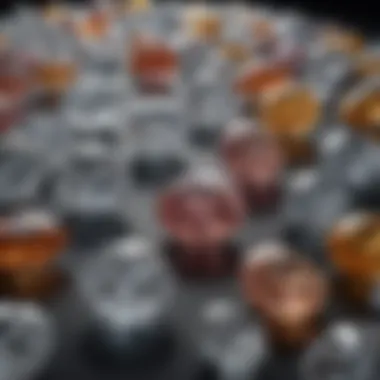
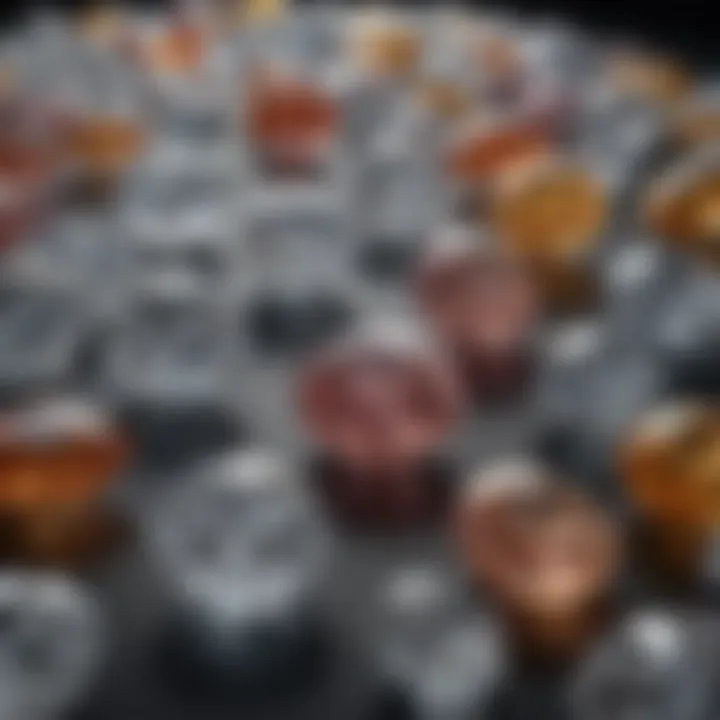
Intro
Diamonds have long been more than mere stones; they symbolize permanence, purity, and passion. In the world of jewelry making, these gems hold a unique and multifaceted role that spans across ages and cultures. As enthusiasts, collectors, and designers explore the allure of diamonds, it's worth diving into their rich history, unique properties, crafting techniques, and cultural significance.
This article aims to present a holistic view of diamonds in jewelry making, uncovering both the technical aspects and the emotional connections that accompany these precious gems. Whether you're a budding designer looking for inspiration or a seasoned collector keen on deepening your understanding, this exploration should illuminate the many facets of diamonds in the jewelry industry.
Gemstone Overview
Definition and Origins
At its core, a diamond is a crystalline form of carbon known for its unmatched hardness and extraordinary brilliance. Formed deep within the Earth under extreme pressure and temperature, diamonds have a fascinating origin story that dates back billions of years. They are formed in a variety of geological conditions, but what sets them apart is the unique crystal lattice that makes them the hardest known natural material on Earth.
Historically, diamonds were believed to possess magical and protective qualities. In ancient cultures, they were often used as talismans to ward off evil forces. The term 'diamond' itself comes from the Greek word adamas, meaning "invincible". This notion of strength has carried through to modern times, reinforcing diamonds' reputation as symbols of love and commitment.
Historical Significance
From the dazzling crowns of royalty to engagement rings, diamonds have a storied past wrapped in tradition and regality. The earliest recorded diamonds were discovered in India around the 4th century BC, where they were treasured for their beauty and rarity. As trade routes developed, diamonds made their way to Europe, and during the Renaissance, they became a symbol of social status and power.
In the 19th century, a significant turning point occurred with the discovery of diamonds in South Africa. This led to the establishment of diamond mining as a major industry, while also paving the way for marketing strategies that redefined how diamonds were perceived by the public. The iconic phrase, "A diamond is forever," coined in the 20th century, reinforced the idea of diamonds as the ultimate expressions of love and commitment.
Gemstone Properties
Hardness and Durability
One cannot discuss diamonds without acknowledging their remarkable hardness. Rated a perfect ten on the Mohs scale, diamonds are resistant to scratches and wear, making them an ideal choice for jewelry meant to withstand the test of time. This exceptional durability is often seen in daily-wear items like engagement rings and wedding bands, where longevity is paramount.
Color and Clarity
The aesthetic beauty of a diamond is often evaluated by its color, clarity, cut, and carat weight, collectively known as the "Four Cs". While many associate diamonds with a clear, colorless appearance, they can actually exist in a range of hues, from a deep blue to vivid pink. Color grading is key; the closer a diamond is to colorless, the more valuable it tends to be in conventional markets.
Clarity refers to the presence of internal or external flaws, known as inclusions and blemishes, which can affect a diamond's brilliance. Understanding these properties helps jewelry makers select stones that would not only appeal visually but also add value in the eyes of collectors and buyers.
"Diamonds are not just investments; they are legacy pieces that tell a story across generations."
Crafting Processes and Techniques
The journey from rough diamond to brilliant piece of jewelry is an intricate process involving expertise and artistry. Diamonds are carefully analyzed before they are cut, ensuring each facet enhances their natural beauty. The art of cutting is central; traditional styles like the round brilliant cut and princess cut continue to be popular, while newer shapes, such as the cushion and oval cut, are gaining traction in modern designs.
Furthermore, the setting of a diamond in jewelry can significantly affect its appearance. Options vary from prong settings, which amplify sparkle, to bezel settings that offer a sleeker, more contemporary look.
Through this narrative, it becomes clear that diamonds are not merely beautiful stones; they have a rich tapestry of history, cultural significance, and a physical beauty that makes them central to the craft of jewelry making. This article seeks to delve deeper into these threads, exploring market trends, design inspirations, and the care needed to preserve diamond jewelry for future generations.
Prolusion to Diamonds in Jewelry
In the realm of jewelry making, diamonds are not just another ornament; they hold a profound importance that resonates through history, culture, and craftsmanship. This section aims to illuminate the unique facets of diamonds, offering insight into their significance as precious stones. One cannot overstate their value in the industry. They are often seen as the ultimate status symbol, a centerpiece that captures attention at any glance. Diamonds, with their captivating sparkle, elevate even the most mundane jewelry design into something extraordinary.
The exploration of diamonds in jewelry goes beyond their aesthetic appeal. From the depths of the earth to the hands of skilled artisans, understanding the journey of these gems sheds light on the complexities involved in their incorporation into jewelry. Notably, diamonds symbolize power and love, a duality that enhances their desirability. Those embarking on a foray into jewelry design or collecting need to grasp the historical and cultural contexts that have shaped diamonds' standing in various societies.
Thus, digging deeper into the world of diamonds equips enthusiasts, collectors, and designers with a well-rounded view of their significance, encapsulating not only the beauty but also the dedication behind their creation.
Overview of Diamonds as Precious Stones
Diamonds occupy a unique position in the hierarchy of gemstones. Known primarily for their brilliance and enduring nature, they have become the benchmark against which other stones are measured. Formed over billions of years under conditions of extreme heat and pressure deep within the Earth's mantle, diamonds have a resilience that is hard to match.
Unlike other gemstones, diamonds possess a hardness rating of 10 on the Mohs scale, which makes them the hardest natural material known. Their structure allows them to reflect light spectacularly, resulting in the coveted brilliance that buyers seek. Beyond their physical properties, diamonds are graded based on the Four Cs: cut, color, clarity, and carat weight. Understanding these specifications is essential for anyone involved in the world of luxury jewelry or mere appreciation.
"A diamond is forever. Its enduring quality not only makes it a sought-after gem but also a lasting symbol of love and commitment."
Diamonds also come in various forms and styles; whether they are classic solitaires or intricate multi-stone settings, each design speaks volumes about the taste of the wearer and the skill of the craftsman. Consequently, their role in jewelry is multifaceted, making them a staple for various occasions—from engagement rings to anniversary gifts, they’re often seen as the ultimate expression of affection.
Cultural Significance of Diamonds
Through history, diamonds have transcended their physical beauty to embody deep cultural meanings. For example, in Western societies, diamonds are frequently associated with love and commitment, particularly as engagement rings symbolize lifelong bonds. The ritualistic aspect of gifting a diamond ring has created a cultural expectation that reinforces its status as a timeless gift.
In addition to romantic symbolism, diamonds have also played roles in royal regalia and national treasures. The imperial crowns of Europe often feature stunning diamonds, imbuing them with an air of authority and grandeur. In Asia, the significance of diamonds varies, sometimes representing wealth and status, while in other cultures, they illustrate a more spiritual connection to the cosmos.
- The perceived value of diamonds often hinges on local customs and traditions.
- In some contexts, they might serve as a mediator in social standing.
Furthermore, the impact of diamonds in art and literature is immense. Often referenced as symbols of purity and endurance, their presence in both contemporary and classical works underscores their enduring appeal. From Shakespeare’s musings on the brilliance of gems to modern-day artists using them as motifs, diamonds continue to inspire and provoke thought across cultures.
Understanding the multifaceted cultural significance of diamonds enhances our appreciation of their presence in jewelry. Through the lens of history, nature, and society, these gems tell a story that is as intricate and compelling as the designs they adorn.
Historical Context
When diving into the realm of diamonds in jewelry making, it’s crucial to grasp the historical context surrounding this illustrious gem. The journey of diamonds from earthy formations to dazzling adornments tells a fascinating tale that not only enriches our appreciation for them but also informs modern practices in the industry. Understanding the historical backdrop highlights the evolving aesthetic, technological, and cultural factors that have shaped how diamonds are viewed and utilized in adornments today.
Early Uses of Diamonds
Historically, diamonds have been cherished not just for their beauty, but for their supposed protective qualities. Early civilizations, such as those in ancient India, recognized diamonds' exceptional hardness and brilliance. In these cultures, they were often believed to possess mystical properties, warding off evil spirits or serving as talismans for strength and bravery. Diamonds were previously used in their uncut, raw forms, often set in the weapons of kings and noble warriors. The legends circulating around these stones taught about their worth, ensuring they were not only symbols of wealth but also signs of power.
"Diamonds were viewed as more than mere decorations; they were the embodiment of divine power."
In various early cultures, the gem found its way into royal jewelry, symbolizing wealth and status. For example, in ancient Rome, diamonds were worn by emperors and often adorned their regalia. From these historical instances, it’s clear how integral diamonds were in representing authority and opulence.
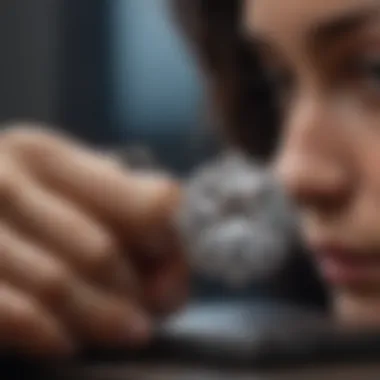
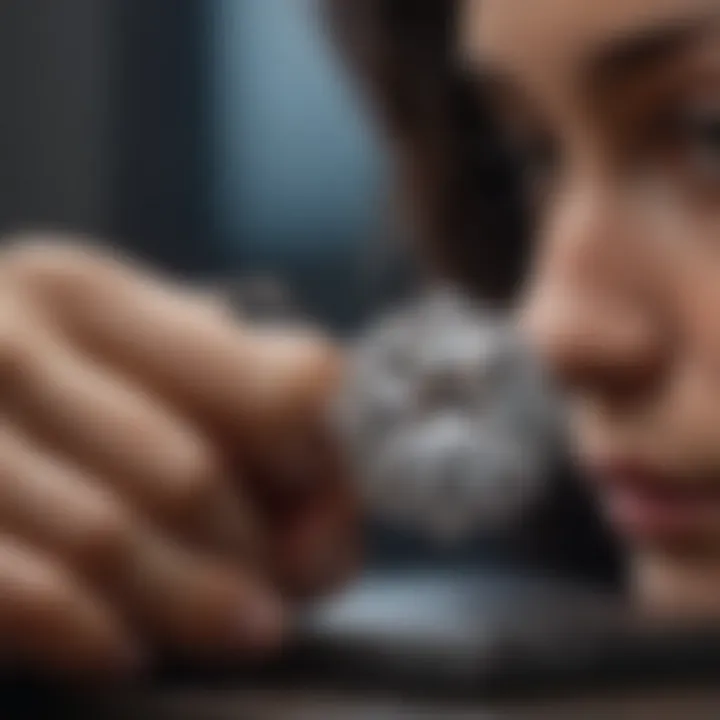
With the advent of the Middle Ages, diamonds began to transition from armor into more ornamental uses. They were cut more precisely to enhance their natural brilliance, stepping away from their rough aesthetic, which marked the beginning of a new trend in jewelry making. The 15th century saw further advancement, where diamonds were not only worn by the elite but also became a key element in the bridal crown as a symbol of enduring love.
Evolution of Diamond Jewelry Trends
As centuries rolled on, diamond jewelry evolved, reflecting societal changes and techonological advancements. The Renaissance period marked significant innovation in cutting techniques, leading to what we recognize now as the rose cut, which maximized the stone’s brilliance. It wasn’t until the 19th century, however, that diamonds came into their own as the ultimate symbol of love and commitment, particularly influenced by the engagement ring trend that arose in Victorian England.
The trend settings continued into the 20th century with the launch of the De Beers campaign in the 1940s, introducing the phrase "A Diamond is Forever.” This campaign did more than sell diamonds; it reshaped cultural perceptions around marriage and commitment, intensifying the public desire for diamond rings.
During this period, styles became more diverse, from vintage Art Deco designs to the more elaborate, eclectic forms of the 1980s. The approach to diamond sourcing also began to diversify, with increased attention to ethical sourcing starting to emerge in the late 20th century as consumers became aware of the implications of diamond mining.
Understanding this historical progression not only lends depth to the study of diamonds in jewelry making, but sets a foundation for practicing jewelry designers and enthusiasts to appreciate their choices better—whether one leans towards traditional settings or modern designs. It also illustrates how diamonds continue to serve as a reflection of societal values, tastes, and innovations.
Types of Diamonds for Jewelry Making
Diamonds hold significant prominence in the realm of jewelry making, not only for their beauty but also for their varied forms. Understanding the types of diamonds available is crucial for craftsmen and consumers alike. The choice of diamond impacts design, cost, and the overall aesthetic appeal of the piece. Each type of diamond offers unique characteristics that can enhance the design or convey specific sentiments in jewelry. This section will discuss three primary types: natural, synthetic, and fancy color diamonds.
Natural Diamonds
Natural diamonds are the classic choice for many jewelers. Formed over millions of years deep within the Earth, these stones come with a story that fascinates many. Their journey from the Earth's mantle to the surface through volcanic eruptions adds an element of rarity to their allure.
There are several benefits to using natural diamonds:
- Timeless Appeal: Natural diamonds have always been coveted; they are often seen as symbols of everlasting love and commitment.
- Investment Value: Their rarity can increase in value over time, making them a viable investment.
- Unique Characteristics: Each natural diamond has its own set of inclusions, called "blemishes," which can add character and uniqueness to the piece.
However, potential buyers should consider some elements:
- Cost: Natural diamonds are usually more expensive due to their rarity.
- Ethical Considerations: Issues surrounding conflict diamonds require a careful selection process to ensure ethical sourcing.
Synthetic Diamonds
Synthetic diamonds, often referred to as lab-grown diamonds, have recently gained traction in the market. They boast the same physical, chemical, and optical properties as natural diamonds but are created in a laboratory setting. This type of diamond is considered a more affordable and accessible option.
Here are a few points that highlight synthetic diamonds:
- Affordability: They generally cost 20-40% less than their natural counterparts, which makes them more appealing to budget-conscious buyers.
- Ethical Sourcing: As they are produced in controlled environments, there are no concerns about conflict or unethical mining practices.
- Customization: Lab-grown diamonds can often be tailored in terms of size, clarity, and cut, giving designers a broader palette to work with.
On the flip side, some garnet jewelers and enthusiasts hesitate:
- Perceived Value: There’s a distinction between natural and synthetic that might affect resale value, making some consumers reluctant to invest in lab-grown options.
Fancy Color Diamonds
Fancy color diamonds, while less common, are rapidly becoming a niche favorite among collectors and jewelry designers alike. These diamonds occur in a variety of vibrant hues including blue, pink, and yellow, each reflecting unique light properties that enhance their visual appeal.
Consider the following aspects of fancy color diamonds:
- Diverse Palette: They come in myriad colors, providing endless creative possibilities for jewelry design.
- Collectible Value: Certain colors and rarities can fetch incredibly high prices in the market, making them intriguing for collectors.
- Symbolism and Sentiment: Colors often carry their own meanings—like blue representing calmness or pink symbolizing love.
Some factors for consideration include:
- Rarity: High-quality fancy color diamonds can be extremely rare and expensive compared to traditional white diamonds.
- Market Demand: The market for these stones can fluctuate, impacting their perceived value over time.
Understanding the types of diamonds available — natural, synthetic, and fancy color — can empower jewelers and consumers alike to make informed decisions based on style, budget, and ethical considerations.
Diamond Specifications
Understanding diamond specifications is crucial for anyone involved in jewelry making. The characteristics of a diamond not only determine its beauty but also its value, making it essential for gem enthusiasts, collectors, and designers alike. By grasping these specifications, one can make informed decisions while creating, purchasing or selling diamond jewelry. The key elements that define diamonds include their cut, color, clarity, and carat weight. Together, these factors guide buyers and artisans in selecting the right diamonds for specific designs or collections.
The Four Cs: Cut, Color, Clarity, Carat
The Four Cs serve as the cornerstone in the diamond industry, helping individuals evaluate diamonds with some level of objectivity.
- Cut: Refers to how well a diamond has been shaped and faceted. A well-cut diamond reflects light in a way that enhances its brilliance.
- Color: Color in diamonds ranges from completely colorless, which is ideal, to shades that can appear yellow or brown. Each diamond's hue affects its value significantly.
- Clarity: This measures internal imperfections or inclusions. The fewer inclusions a diamond has, the more valuable it typically is.
- Carat: Simply put, carat measures the weight of the diamond. Larger stones are rarer and generally command higher prices.
Though these might seem like just numbers, they tell the entire story of a diamond. A great diamond designer must use these specifications as tools, blending them artfully to achieve not only aesthetic appeal but also optimal market value.
"A diamond is a chunk of coal that did well under pressure." - Anonymous
Understanding Diamond Grading
Evaluating diamonds requires a good grasp of the grading system. The Gemological Institute of America (GIA) is one of the most recognized authorities in this domain.
- Certification: It’s essential to seek out diamonds that come with certifications from reputable grading institutions. This ensures that the diamond’s Four Cs have been objectively assessed.
- Grading Scales: Typically, grades range from Excellent to Poor. For instance, cut grades will indicate how well a diamond reflects light, while color grades will show its lack of hues.
- Creating Value: A clear understanding of grading can guide designers in choosing diamonds that resonate with their vision while also catering to market demands.
The grading process adds another layer of significance to diamonds, allowing both buyers and creators to appreciate not only the beauty but also the complexities that come with these gems. When integrated into jewelry design, these specifications help in maintaining a balance between artistry and accountability to consumers.
Designing with Diamonds
Designing with diamonds is not merely a craft; it’s an art form that intertwines creativity, culture, and technology. The significance of this section lies in understanding how diamonds can be both a canvas and a muse for jewelry makers. Diamonds, with their unmatched brilliance and durability, have a unique ability to elevate any design. In this part of the article, we will explore the various aspects of designing with diamonds, including inspiration sources, contemporary techniques, and how to creatively combine these gems with other stones to achieve breathtaking results.
Inspiration from Nature and Culture
When it comes to crafting beautiful jewelry, insights from the natural world and cultural motifs serve as foundational sources of inspiration. Nature often embodies diverse shapes, colors, and textures which can be mirrored in designs.
Consider the intricate patterns of a snowflake; its unique formation can inspire a diamond pendant that captures the delicate beauty of winter. Nature holds a treasure chest of ideas—from the flowing lines of a river to the lattice of tree branches, all of which can be creatively integrated with diamonds to enhance aesthetic appeal.
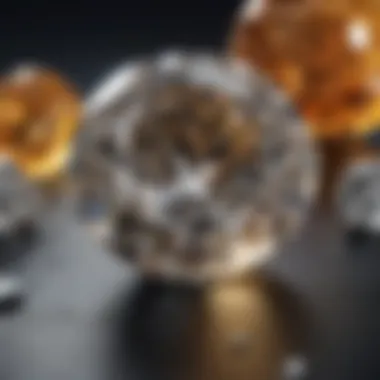
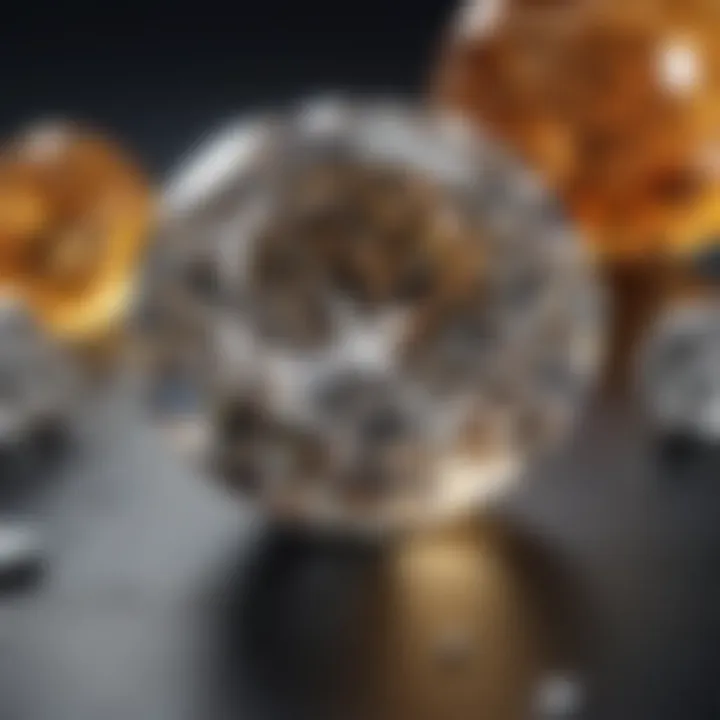
Cultural significance cannot be dismissed, either. Across multiple societies, diamonds have held diverse meanings—status, love, commitment. Drawing from these symbols can enrich a design beyond just aesthetic value. For instance, combining diamonds with cultural symbols like mandalas or tribal patterns can create pieces that tell a story.
Contemporary Design Techniques
In the fast-evolving landscape of jewelry making, contemporary design techniques profoundly change how diamonds are utilized. Today’s innovative jewelers are not limited to traditional settings. Instead, methods such as 3D printing and CAD (Computer-Aided Design) open the door to intricate, customized pieces that were previously unimaginable.
Additionally, using advanced laser-cutting technology allows for precision that enhances the stone's brilliance. Jewelers can create settings that maximize light reflection, ensuring that each diamond sparkles like a star in the night sky. This degree of precision helps differentiate modern designs from older styles that relied heavily on the hand-crafting methods.
Furthermore, incorporating non-traditional materials, like resin or metals blends, can enrich the design while allowing diamonds to take center stage.
Combining Diamonds with Other Gemstones
The beauty of diamonds is undeniable, but their luster can become even more pronounced when combined with other gemstones. This practice not only diversifies the color palette but also adds textures and meanings to the overall piece.
For instance, pairing diamonds with sapphires can yield a stunning contrast; the rich blue of sapphires harmonizes beautifully with the clear brilliance of diamonds, creating an eye-catching effect. Additionally, adding rubies introduces a bold red that symbolizes passion and love, enhancing the emotional resonance of the jewelry.
When considering combinations, it’s essential to think about the arrangement. A traditional row setting, where diamonds are set alongside other gems, creates a timeless look, while a more chaotic, organic arrangement offers a modern vibe. It is worth noting that each gemstone brings unique characteristics, which can influence the overall aura of the jewelry piece.
"Designing with diamonds is like crafting dreams. You have to blend techniques, inspiration, and materials thoughtfully to create something ethereal."
Crafting Techniques in Jewelry Making
Crafting techniques play a pivotal role in the field of diamond jewelry making. They are the backbone that determines not only the aesthetic appeal but also the durability and value of the final piece. Each technique has its distinct characteristics and benefits, catering to different styles and preferences among designers and collectors alike. As the jewelry industry evolves, the integration of both traditional craftsmanship and modern innovations continues to shape the landscape of diamond jewelry.
Incorporating diamonds into jewelry is an art form. The method used to set the diamonds can drastically impact how light interacts with these precious stones, resulting in various effects that enhance the wearer's experience. Moreover, understanding these techniques equips jewelers with the knowledge to create bespoke pieces that resonate with the individual tastes of their clientele.
When choosing techniques, factors such as durability, design complexity, and maintenance must be considered. Such elements influence how a piece wears over time and how it will be perceived in terms of both fashion and function.
Traditional Setting Methods
Traditional setting methods have a charm that often reflects the cultural heritage of jewelry making. Techniques like prong, bezel, and pave settings have stood the test of time and serve distinct purposes. For instance, prong settings utilize metal claws to secure the diamonds, allowing the stone to capture maximum light and sparkle. This method is widely adored for its classic elegance and is often employed in engagement rings.
On the other hand, a bezel setting offers a more contemporary feel, enclosing the diamond in a metal rim that provides both security and protection. This method is favored for its minimalist appearance, which focuses heavily on the diamond itself.
Pave settings, wherein smaller diamonds are set closely together, create a continuous shine that can transform an ordinary piece into something extraordinary.
While these age-old techniques require an innate skill and precision, they also allow for a substantial amount of creativity. Jewelers can play around with various metals and styles to cater to a more personalized approach for clients.
"Every piece created with traditional techniques carries a story; from the artisan's hands to the wearer's heart."
Modern Techniques in Diamond Setting
The rise of technology has revolutionized diamond setting techniques, ushering in an era of precision and innovation. Laser engraving and CAD (Computer-Aided Design) are among the most transformative processes. Laser technology allows jewelers to create intricate designs that were previously almost impossible to achieve, enhancing the customization aspect of jewelry making. This is particularly beneficial for creating unique pieces that reflect the wearer’s personality.
CAD, on the other hand, plays a crucial role in the design phase. It enables jewelers to visualize their concepts in a 3D format before a single diamond is set. This not only streamlines the production process but also minimizes the chances of errors. Customers can engage in the process, visualizing different configurations and styles at their fingertips.
Another modern technique gaining traction is tension setting, where the diamond is held in place by the tension of the surrounding metal, giving the illusion of floating in mid-air. This technique is particularly striking and appeals to those seeking a blend of modern aesthetics with timeless elegance.
Ultimately, as these modern techniques blur the lines between art and technology, they offer jewelers and customers alike fresh ways to enjoy diamond jewelry. Each method—from traditional to modern—provides its unique flair, enriching the tapestry of diamond jewelry making.
Market Trends in Diamond Jewelry
The specific focus on market trends in diamond jewelry is pivotal for anyone invested in the jewelry industry, from designers to collectors. Understanding what’s currently in vogue gives jewelers insights into consumer behavior, leftover stock from prior seasons, and what new collections might capture buyers' interests. Moreover, market trends help predict future movements and shifts in styles, materials, and purchasing patterns.
In recent years, consumers have become increasingly discerning, valuing not just the aesthetic appeal of diamonds but also the ethics behind their sourcing. Trends indicate that buyers are inclined towards diamonds that align with their personal values, which could range from origin to craftsmanship. This evolving landscape makes it imperative for jewelers to keep their ears to the ground.
Current Consumer Preferences
The landscape of diamond jewelry is ever-changing, shaped by various factors including demographics, societal shifts, and individual values. These preferences reveal meaningful insights into what modern consumers seek when purchasing diamond jewelry.
- Sustainability: A growing number of consumers are prioritizing sustainable and ethically-sourced diamonds, making sure they are not contributing to conflicts or environmental harm.
- Personalization: Unique, custom-made pieces are becoming more desirable over mass-produced offerings. Consumers seek to express their individuality through tailored designs.
- Transparency: Customers are demanding clarity about the source and grading of diamonds. They are inclined to buy from sellers who proudly provide detailed documentation and certification of their gems.
- Alternative Stones: While diamonds remain a staple, consumers are increasingly open to alternatives such as lab-grown diamonds or colored gemstones, looking for something fresh and distinctive.
"Today's diamond buyers are not just looking for a rock; they want a story, a meaning behind their choice, reflecting personal beliefs and experiences."
The Impact of Social Media on Trends
The digital age has reshaped the way diamond jewelry is marketed and perceived. Social media platforms have become powerful tools in shaping consumer perceptions, trends, and purchasing decisions.
- Influencer Culture: Platforms like Instagram and TikTok amplify voices of influencers who advocate for different jewelry styles. Their endorsements can prompt spikes in demand for certain designs or types of diamonds almost overnight.
- Global Exposure: Social media enables users to see diverse ways diamonds are incorporated into fashion globally. This has broadened consumer tastes and raised awareness, making trends more fluid and volatile.
- User Generated Content: Consumers are sharing their own jewelry stories and purchases online, creating a community of authenticity that can sway others to make similar choices.
- Direct Engagement: Brands now interact directly with consumers, addressing their preferences swiftly and providing a personalized shopping experience. This two-way conversation impacts design choices and marketing approaches.
The trends in diamond jewelry are an intricate blend of changing preferences and modern technology. Keeping up with these dynamics is essential for anyone immersed in the field, whether they are producing, selling, or purchasing jewelry.
Ethical Considerations
The importance of ethical considerations in diamond jewelry making cannot be overlooked. As consumers become more conscientious about their purchases, the demand for ethically sourced diamonds has surged. This reflects broader societal trends prioritizing sustainability and social justice. Ethical sourcing not only builds trust between consumers and sellers but also fosters better practices across the industry. It encourages miners and suppliers to follow responsible practices that respect both human rights and the environment.
Conflict Diamonds and Their Implications
Conflict diamonds, often referred to as blood diamonds, have dark implications linked to their origins. These stones are mined in war zones and sold to finance armed conflict against governments. Several regions in Africa, such as Sierra Leone and Angola, have faced this very issue. The repercussions are dire, resulting in violence, human rights abuses, and environmental degradation, tarnishing the image of these otherwise coveted gems.
"Conflict diamonds are not just stones; they carry the burden of human suffering."
For discerning buyers, the knowledge of a diamond’s origin is critical. Many consumers now opt for diamond sellers who can provide certifications proving that their gems are conflict-free. Various industry initiatives, such as the Kimberley Process Certification Scheme, aim to limit the flow of conflict diamonds. However, critics argue that this system has loopholes that need addressing to effectively eliminate the trade in these stones.
Sustainable Sourcing of Diamonds
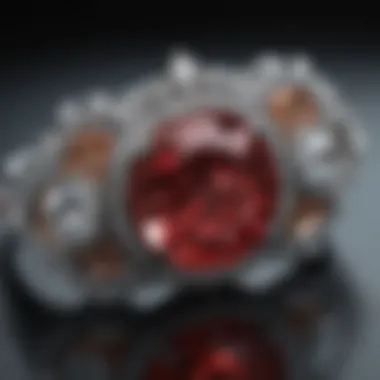

On a positive note, sustainable sourcing practices are emerging as a crucial aspect of the diamond industry. This approach seeks to ensure that the diamonds are not only conflict-free but are also mined in ways that have minimal environmental impact and promote community development. Companies are increasingly adopting better mining techniques, which reduce soil disruption and water contamination.
Additionally, brands that prioritize sustainable diamonds often engage in fair trade practices, ensuring that local communities benefit from mining activities. This can include providing fair wages, funding education, and improving local infrastructure. Buyers can support these ethical practices by choosing to buy from companies that are transparent about their sourcing methods and the impacts on the communities involved.
The integration of these ethical considerations into the diamond market illustrates a significant shift in consumer attitudes. As transparency becomes more achievable owing to technological advancements and shared information, the future of diamond jewelry making might just become a beacon of ethical luxury.
Caring for Diamond Jewelry
Caring for diamond jewelry is not just about ensuring that these precious stones retain their sparkling appeal; it's about the value and memories they hold. Diamonds, often seen as the ultimate symbol of love, status, and artistry, require more than just a glance in the mirror. Attention to their care is necessary to maintain their brilliance and structural integrity. Knowing how to properly clean, maintain, and store diamond jewelry is essential for enthusiasts, collectors, and jewelers alike. Let’s dive into the specifics of how to give your diamonds the TLC they deserve.
Cleaning and Maintenance Tips
Keeping diamond jewelry clean is paramount. Over time, dirt, oils from the skin, and environmental pollutants can build up, dulling their shine. Here are some practical tips to ensure your diamonds glisten:
- Regular Cleaning: Use a soft brush, like a toothbrush, and a gentle soap solution—preferably mild dish soap mixed with warm water. Dip the brush in the solution and scrub gently beneath the stone and around the setting.
- Professional Cleaning: Consider bringing your jewelry to a professional jeweler for cleaning every six months. They have specialized equipment that can restore your diamonds to their original luster with ease.
- Avoid Harsh Chemicals: Steer clear of strong cleaners like bleach or ammonia, as these can damage the metal settings and even the diamonds themselves.
- Check Settings: While cleaning, take a moment to inspect the settings. Ensure that the diamonds are secure and that there are no visible signs of wear or damage.
"Regular cleaning helps sustain not just the appearance, but also the longevity of diamond jewelry. Every gem tells a story, and a well-maintained piece retains its narrative through the years."
Storage Recommendations
How one stores their diamond jewelry can make a world of difference in preserving its quality. Avoiding unnecessary damage while it's not in use is key:
- Use Soft Pouches: Store each piece in its individual pouch made of soft fabric. This prevents scratching on the diamond or other gemstones nearby.
- Avoid Jewelry Boxes with Compartments: While it might seem convenient, compartments can lead to friction that scratches the surface of the diamonds.
- Keep Away from Direct Sunlight: Exposure to direct sunlight may fade certain gemstones or cause some metals to tarnish. Choose a cool, dark spot for storage.
- Separate from Other Jewelry: Try to avoid storing diamonds with other jewelry. Doing so minimizes the risk of scratches or damage. Consider using a dedicated jewelry box or a separate compartment.
Managing diamond jewelry involves more than just how they look; it’s a commitment to preserving their beauty and integrity over time. As diamonds are likely to be cherished heirlooms or gifts, giving them the care they require ensures they remain a joy to wear and a proud possession.
Purchasing Diamonds for Jewelry Making
Acquiring diamonds is a pivotal step in jewelry making. The right choice not only enhances the overall beauty of the piece, but it also reflects one’s personal style and intentions. In a market teeming with options, knowing where to buy quality diamonds, along with evaluating the sellers responsibly, becomes crucial. Understanding these aspects can ultimately safeguard your investment and amplify the emotional value of the jewelry.
Where to Buy Quality Diamonds
Finding reputable sources is key when purchasing diamonds. Here are a few notable places to consider:
- Local Jewelers: Visiting local jewelers allows for a closer examination of diamonds. You can appreciate the nuances of each stone in person and ask questions directly.
- Online Retailers: Websites like James Allen and Blue Nile have gained popularity due to their extensive inventories and detailed imagery. They often provide comprehensive information about each diamond.
- Diamond Wholesalers: If you’re looking for better pricing without sacrificing quality, checking in with diamond wholesalers can be beneficial. Often, they sell directly to consumers.
- Auctions: For unique pieces, auction houses can be treasure troves. However, it requires knowledge of the bidding process and research on past diamonds sold.
Evaluating Diamond Sellers
When it comes to evaluating diamond sellers, due diligence is necessary. Here are several factors to consider:
- Certificates of Authenticity: Look for diamonds that come with certification from organizations like the Gemological Institute of America (GIA). A credible certificate validates the quality and characteristics of the diamond.
- Seller Reputation: Research the seller's background through reviews, ratings, and any available consumer feedback. Platforms such as Reddit can provide insights, but cross-reference to ensure reliability.
- Return Policy: A transparent return policy indicates the seller’s confidence in their products. If you're not satisfied with your purchase, being able to return the item can prevent buyer's remorse.
- Customer Service: Good communication is essential. Reliable sellers should be willing to address your queries promptly and competently.
- Pricing Transparency: Be wary of sellers who are evasive about pricing. Genuine sellers should provide a clear breakdown of costs, including any hidden fees.
Cultural Impact of Diamonds
When it comes to diamonds, they are not just rocks dug out from the Earth. Instead, they hold a deep-seated significance that stretches across various cultures and time periods. The cultural impact of diamonds in jewelry making is vast, influencing not only fashion and design but also social customs, rituals, and emotions.
Diamonds have become synonymous with status, luxury, and success. They often symbolize love and commitment, especially in engagement rings. Couples see diamonds not simply as a piece of jewelry but as tokens of their devotion, making them a staple in matrimonial traditions. Going beyond personal relationships, diamonds have created a ripple effect across society, altering everything from gifting customs to even business traditions. This symbolic weight carries cultural implications that can be observed in various social settings.
Symbolism in Relationships
Diamonds function as powerful symbols in relationships, often associated with enduring love and commitment. The tradition of gifting a diamond for engagements is deeply rooted in history, initially popularized by the De Beers’ slogan, "A Diamond is Forever," which suggests that love, much like the stone, is everlasting. This phrase etched itself into the minds of many and continues to resonate today.
From engagements to anniversaries, the ritual of giving diamond jewelry communicates deep emotional stakes. Here are some key points to consider about their symbolism:
- Commitment: The diamond engagement ring represents the promise of a future together.
- Status: Giving a diamond often signifies social standing; it indicates one’s ability to provide.
- Heritage: Generational passing down of diamond pieces imbues them with familial significance.
Diamonds also appear in literature and art as metaphors for enduring love, often depicted in stories where characters gift diamonds as proof of their love. It’s fascinating how one stone can carry such weight across different lives and narratives.
Diamonds in Art and Literature
Diamonds have been a muse for countless artists and writers throughout history. From Shakespeare’s poetic references to modern novels, the allure of diamonds traverses genres and eras. They often appear in artworks that depict themes of wealth and power, drawing people’s attention to human desires and aspirations. However, the mention of diamonds isn’t confined to just tangible descriptions; they often represent abstract ideas such as desire, envy, and the complexities of human relationships.
In literature, diamonds have taken on metaphorical meanings, sometimes symbolizing the futility of consumerism or the transient nature of beauty. Here are a few notable appearances of diamonds in art and literature:
- Shakespeare's Sonnets: Diamonds epitomize beauty and the fragility of life.
- "The Great Gatsby" by F. Scott Fitzgerald: Sparkling diamonds signify the opulence and futility of the American Dream.
- Modern Art: Artists have used diamonds in various forms to critique or celebrate wealth and status.
"Diamonds are, at once, the embodiment of luxury, and yet they can also represent the emptiness of unfulfilled desire."
The End and Future Outlook
The significance of understanding the evolving dynamics of diamonds in jewelry making cannot be overstated. This section aims to encapsulate the key findings of the article while looking ahead at what the future might hold for this iconic gemstone in the industry.
The Evolving Role of Diamonds in Jewelry
Diamonds have long been celebrated for their brilliance and value in the world of jewelry. Over the years, their role has transformed subtly, influenced by changing tastes, technological advancements, and shifting cultural paradigms. In contemporary design, diamonds are not just seen as symbols of wealth or luxury; they are also integral to artistic expression, with designers weaving them into narratives that resonate with personal stories or environmental themes.
The contemporary consumer increasingly seeks personalized jewelry that reflects their individuality. As a result, the traditional diamond engagement ring isn't the sole focal point anymore; unique pieces utilizing diamonds in unexpected designs have taken the spotlight. For instance, asymmetrical settings and unconventional cuts are gaining traction. There’s a certain allure in a diamond that tells a story; the idea that each facet symbolizes a chapter of one's life.
Furthermore, the rise of ethical considerations surrounding diamond sourcing has altered consumer expectations. Shoppers are more informed and concerned about the origins of their precious stones, which has put pressure on designers to prioritize sustainable and conflict-free sourcing practices. This shift has opened a dialogue about the intrinsic value of diamonds, challenging the industry to consider not just their aesthetic appeal, but the broader implications of their procurement.
"The future of diamond jewelry lies in storytelling, ethics, and personal expression."
Emerging Technologies in Diamond Production
In terms of technology, the diamond industry is witnessing a revolution, largely driven by innovations in synthetic diamond production. The methods like chemical vapor deposition and high-pressure high-temperature processes have not only made diamonds more accessible but have also paved the way for increased experimentation in design. Synthetic diamonds often boast impeccable clarity and color, making them increasingly popular among buyers looking for high-quality stones at lower prices.
As a consequence, we might also see advancements in grading techniques; enhanced precision in the evaluation of a diamond’s characteristics will empower designers and consumers alike. New grading technologies are allowing for a more transparent purchasing process that helps in evaluating the true value of a diamond. With everything from blockchain tracking to AI-assisted grading, the landscape is changing fast.
Moreover, we are on the cusp of potential breakthroughs in the way diamonds are treated and treated with more focus on customization. Augmented and virtual reality tools might soon enable customers to visualize how a diamond will look in a final piece before it’s crafted, thus fostering a deeper connection to the jewelry itself.
As we consider the future of diamonds in jewelry making, it's clear that the interplay between tradition and innovation will define the pathway forward. By balancing the rich heritage of diamonds with the contemporary demands of ethical sourcing and technological breakthroughs, the jewelry market can navigate the complexities of modern consumerism while continuing to celebrate the enduring allure of these remarkable stones.



